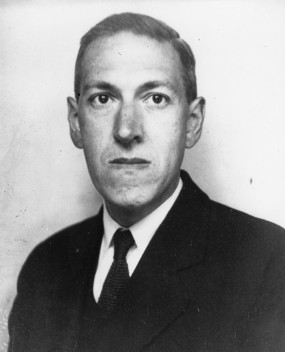"The Menaces the Future May Bring Forth"
Lovecraft and the Posthuman

"I shivered at the mysteries the past may conceal, and trembled at the menaces the future may bring forth. What was hinted in the speech of post-human entities of the fate of mankind produced such an effect on me that i will not set i down here." - H.P. Lovecraft: The Shadow Out of Time in Astounding Stories, June 1936
In Tuesday's post I mentioned the obvious Lovecraftian influence in Jeff Vandermeer's Annihilation, so today I will elaborate on that by briefly looking at the way the posthuman is portrayed in the works of H.P. Lovecraft.
In Lovecraft's novella The Shadow Out of Time from 1936, we encounter one of the very first uses of the term "post-human" in popular fiction. Like so many of the stories of the notorious weird fiction author, the narrator is telling the story of how he experienced horrifying events almost beyond all comprehension, leaving it up to the reader to decide if he has gone mad or not.
In this particular case, the protagonist has suffered five years of amnesia, during which he appears to have been a different person entirely. When he regains his memory, he also vividly remembers visions of visiting a pre-human civilization capable of projecting (or, in modern terms, uploading) their minds into intelligent beings in the past and in the future.
Fearing for his sanity, he begins researching ancient to find a rational explanation for his memories. In the secret history of the world he uncovers, there are several tropes of the posthuman at work that would later influence other formations of posthuman folklore such as the superhero genre, which had strong ties to the pulp monsters of the thirties: The “Great Races” the narrator investigates are civilizations predating human evolution, but with many similarities to humankind. They are, however, supposedly alien and horrifying to even read about, so in order to evoke that sense of dread in the reader, they are all hybrids of animal and human traits. The race which turns out to have stolen the narrator’s mind for the duration of his amnesia have squid-like arms and snail-like bodies. These beings also fear a civilization predating them, the “star-faced”, winged Old Ones made famous by another Lovecraft story, The Call of Cthulhu. This hybridization of human and animal forms are a fundamental mechanism in both Marvel’s X-Men series and in the numerous depictions of extraterrestrial aliens in popular culture.
What is perhaps even more interesting is the reason why the story uses the term “post-human”: The ancient history describes not only prehuman civilizations, but also the civilizations that will emerge after us, since the snail-squid race is able to project its minds into the future. Humankind will be succeeded by a “post-human beetle race”, which indicates that mankind will not evolve in a traditional “upwards” curve towards something celestial or angelic, but will be destroyed and give way to the ascendancy of a completely different species.
In this way, Lovecraft inscribes humanity into a story of a revolving wheel of evolution that is not characterized by continuity or “progress”, but by the idea that humanity and civilization might just be a fraction of a second in an endless procession of disconnected civilizations, and that our significance to Nature and to Earth might be far smaller than we imagine.
This is the main source of horror and dread in Lovecraft’s stories: A destabilization of the anthropocentric viewpoint, not by emphasizing the importance of nature and animals, but by shoving us down the steps of the evolutionary ladder and conjuring visions of pre- and post-human intelligences to which we are, at best, interesting archaeological artifacts of a brief moment in the endless history of the universe.
